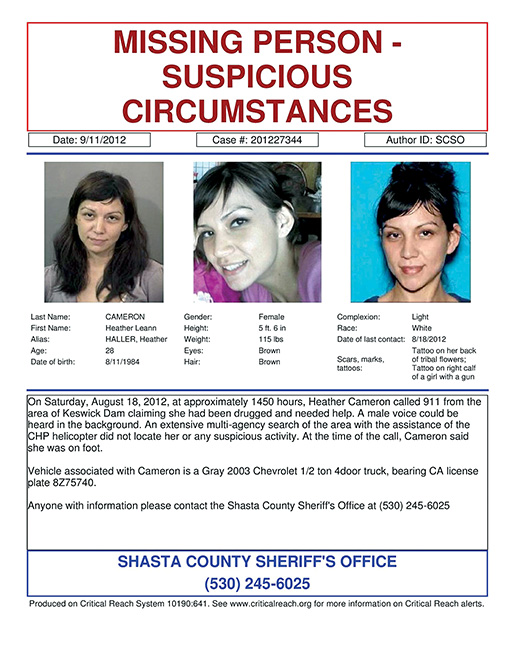Tribal Government & News
Federal report on missing, murdered Indigenous people in Oregon includes Heather Cameron case

By Danielle Harrison
Smoke Signals staff writer
PORTLAND – The U.S. Attorney’s Office for the District of Oregon released its first Missing and Murdered Indigenous Persons report on Friday, Feb. 19.
The report is the first to be released by any U.S. Attorney’s Office since the Justice Department began a new program, nicknamed Operation Lady Justice, to address the ongoing crisis of missing and murdered Native Americans.
The Oregon report provides Tribes, law enforcement and the public with an overview of current cases as well as the Attorney’s Office plans to address the crisis in 2021.
The report includes summaries of eight murdered and 11 missing Indigenous people, including Grand Ronde Tribal member Heather Cameron, who has been missing since August 2012 from a remote area near Redding, Calif.
On the day of her disappearance, Cameron called 911 three times from her ex-boyfriend Daniel Lusby’s cell phone near the remote Keswick Dam area in Shasta County, saying she had been drugged and needed help. A male voice was audible in the background, according to police reports.
Police conducted an extensive, multi-agency search, according to the Shasta County Sheriff’s Office. Lusby was interviewed as a primary person of interest in the case on three separate occasions, but never arrested.
Although Cameron went missing in California, she is included as part of the Oregon data because she is a member of an Oregon Tribe, according to the report.
During report research, it was discovered Cameron was still listed as “white” in the California Missing Person Clearinghouse, which is a racial misclassification. These gaps in data can often lead to inaccurate and underreporting of how many Indigenous people are missing and murdered nationwide.
“Our priority in 2021 is to formally consult with Oregon Tribes and collect and maintain all available data,” the report stated. “The USAO is also committed to track and assist in any missing and murdered Indigenous person cases connected to the District of Oregon, including Oregon Tribal members that are outside of Oregon.”
Grand Ronde Domestic Violence Program Coordinator Danielle Murrell said that the Oregon U.S. Attorney’s Office work is vital in bringing more attention to address the epidemic of missing and murdered Indigenous people throughout the country.
“We know that American Indians/Alaskan Natives experience violence and sexual violence at a disproportionate rate (compared to) nonAmerican Indians/Alaskan Natives,” she said. “This makes the USAO’s work of momentous importance to continue to bring awareness to this problem. In (the) Urban Indian Health Institute’s 2016 report, they noted that 95 percent of the murdered and missing Indigenous women and girls cases never received national or international news coverage. This is a problem.
“Not having accurate reporting has also prevented researchers from gaining a true understanding of the problem, in addition to inconsistent racial misclassification and jurisdictional issues. The USAO’s efforts plan address these barriers.”
The 2021 Missing and Murdered Indigenous Persons Action Plan includes the following goals:
- Tribal consultations: Schedule virtual meetings with each federally recognized Tribal government and Tribal law enforcement entity in Oregon.
- Gather data: Request information from all law enforcement offices that respond to Oregon Tribes or Tribal offices that have data.
- Develop Tribal community response plans: Work with each Tribe to establish Tribal response plans that would include creating four different protocols of community outreach, law enforcement agency response, victim services, and public and media communications customized for each Tribe.
- Creation of a working group: Invite Tribal representatives and law enforcement to establish a District of Oregon Missing and Murdered Indigenous Persons Working Group to share information and work to address issues.
- Increase collaboration and communicate: Collaborate with all Oregon law enforcement to better track and provide assistance in all missing and murdered Indigenous cases, including Tribal members who are outside of Oregon.
- Address issues found in Oregon State Police report: Work with Oregon State Police to overcome the barriers identified in its 2020 report. This includes addressing gaps in data and information sharing, improving communication between different jurisdictions involved in investigations, and facilitating resource sharing.
“For generations, American Indians and Alaskan Natives have suffered from disproportionately high levels of violence. Tragically, this is not a crisis of the past; it’s a crisis of the present,” outgoing Oregon U.S. Attorney Billy Williams said. “In this report, we look back and forward, summarizing what is known about missing and murdered Indigenous people in Oregon and outlining our plans and goals for the year ahead. While we won’t solve this problem overnight, our office is working closely with Oregon law enforcement partners, other U.S. Attorney’s Offices, and the U.S. Department of Justice to end endemic violence in Indian Country.”
